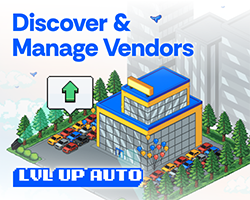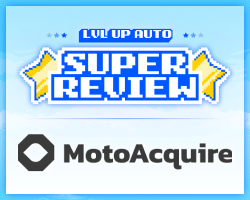 All of my DealerRefresh articles are inspired by something I have come across recently. This one is certainly no exception. As most dealership employees whose job focuses around “the Internet” I too wear quite a few hats. One of those hats screams I am the CRM Dude at my dealer group. It is actually one of my favorite responsibilities because it is a never-ending cycle of developing better process, and I find that fun! In my travels from store to store, I come across the same question from frustrated sales people again and again:
All of my DealerRefresh articles are inspired by something I have come across recently. This one is certainly no exception. As most dealership employees whose job focuses around “the Internet” I too wear quite a few hats. One of those hats screams I am the CRM Dude at my dealer group. It is actually one of my favorite responsibilities because it is a never-ending cycle of developing better process, and I find that fun! In my travels from store to store, I come across the same question from frustrated sales people again and again:
Why hasn’t this CRM stuff helped me sell any more cars?
The answer is – it has! However, there are reasons why this question is being asked in the first place:
- Redundant Dealership Processes
- Too many customers
- Too many CRM’s/systems
These three things work together to destroy a dealership employee’s ability to buy into CRM.
I am very fortunate to have access to someone who I regard as “Mr. Dealership Process” who works for a CRM company and travels around the country. He is also a good friend who has helped me with all my CRM questions over the past few years. He asked to remain anonymous in this article, but I have to credit him with helping me write the rest of this.
1. What does a CRM really do?
Technically it is a Contact/Customer Relationship Management tool, but we don’t use it that way. We use CRM as a tool to capture and move “data”. We rarely think of that data for what it really is; a live person that could potentially become a customer in the future. Instead all we want to do is make them disappear because we get sick of seeing their names on our screens. However, real CRM power comes in the form of what it creates for the future. The Future….Yeah, the really bad F word in our vocabulary. Unless we’re executives, we’re not thinking too much about the future. We’re in it for Now, Now, Now! Even managers and owners condition sales people to focus on NOW. Successful, veteran, sales people will tell you the real magic of sales is repeat and referral business that comes after 3-4 years of constant follow-up that cultivates a database or “live person base” without fail.
Pair a now culture (read Why We Suck) with something that makes us move into a planning culture and we’re doing battle. Call it Old School vs. New School if you like.
2. What does a CRM rely on?
The phone. For the vast majority of dealerships phone training is either a 30 minute Saturday morning meeting or a very expensive “trainer” from the outside. And when we were trained by our managers, in the dealership, it was mostly about what to do when the customer is at your desk, not about what to say on the phone or in an email. CRM works to get a customer to your desk where you are at your best. It does little for you when the customer is actually there.
If you get better on the phone, CRM will help you sell more cars. Plowing through the calls each day that are scheduled in the CRM by just clicking buttons will not help you sell more cars. You must work at your voicemail messages and appointment closing techniques each day if you want to achieve incremental sales success in the future.
3. Creating Process
CRM makes us build process. We have to plan ahead for all those follow-ups we’re going to place on our staff. Does it make sense to “set it and forget it” when it comes to your follow-up processes? This should be one of the biggest focuses your dealership has because this is where the rubber meets the road. Remember to put your best people on your biggest opportunity.
This is where buy-in comes from the strongest. Make sure each opportunity that is scheduled in the CRM adds value to the user. One of the biggest reasons sales people and managers don’t completely buy-in is due to the fact that scheduled CRM follow-ups are redundant or meaningless opportunities based on the current status of the customer.
Make sure that the decision makers, in your company, interview top performing sales people at least once a year to better understand what is working and not in regards to your follow-up processes. This will help make sure your organization is keeping pace with your staff’s experience levels and customer trends.
This is how you fix the two items I mentioned at the beginning of this article: 1. Redundant Dealership Process and 2. Too Many Customers on daily follow-up. It will dramatically affect overall dealership buy-in to the CRM.
Instead of thinking about it as how can this help me now, also think about it as how can this help me 3 years from now.
4. Too Many Systems
If you have an ILM and a CRM, consolidate! There are way too many options on the market to continue to make some of your staff work out of multiple systems. There are even CRM companies that offer inventory support, service writing, penciling, and the list goes on and on. If your sales managers are working out of more than 3 systems (CRM, Inventory, Used Car Pricing, ILM, Penciling, OEM System, etc) it is time to re-look at what you’ve got.
With too many systems, you cannot expect someone to handle all perfectly. It’s tough to expect your managers to inspect what you expect if they have to login, learn, and master multiple systems; which is what it takes to hold the sales staff accountable.
5. Expectations
What do you want your technology to do for you? Did I mention process yet? Did I mention planning for the future?
Okay, you want your technology and employees to sell more cars, but how do you want them to do it? There are some very simple questions you need to think through. How do you want a sales agent to bring a deal to a manager? At what point does a vehicle going through reconditioning get too old in the reconditioning process? Have you addressed these basic things, and if so, how do you implement your wants into your CRM?
Here are few best practice “Expectations” to move your CRM effort to the next level:
- All customers logged into CRM and no deals started without a worksheet printed from the system.
- Managers will take turns reviewing CRM challenges and re-training the staff during each weekly sales meeting for at least 90 days. This practice will help advance the aptitude and overall adoption of the system)
- All salespeople are required to touch the manager’s desk at the end of each shift to ensure that at least 10 quality out bound opportunity calls are completed.
- All salespeople are required to ask for a preferred email address on each new customer. Any salesperson with an email penetration rate below 50% on Walk-In customers will be subject to immediate review.
- All Appointments listed in the CRM must be confirmed by a sales manager before 11:00a each day. (Is the customer actually coming and a second voice/face for the customer that is someone that can “Make the Decision”.)
- Any salesperson that fails to schedule at least two appointments per week from opportunity calls will be subject to an immediate manager review and phone technique critique.
- Salespeople caught moving opportunity calls for a customer out more than 21 days without cause in notes will be subject to the following: a. First Offense (re-train) and b. Second Offense (verbal/written warning).
Question yourself. Question your people. Let your people question you. Discover your expectations; put them in writing, post them in high traffic areas of your dealership, and then put them to work.
Conclusion
If you just skipped any of the 5 points, and just skimmed down to this conclusion, then you’re short-changing yourself. I bet there is something for you in each point that can be immediately applied at your dealership.
CRM, like sales, is simply a numbers game. The more customers you talk to, and the more appointments you set, the more you will sell. However, the numbers are playing against us these days. The Up Bus isn’t rolling up anymore. So, is it time to strategically think about your process from soup to nuts and make your technologies work to your process expectations? Instead of just playing the numbers, set your staff up for quality too. But be careful not to overburden them further.







